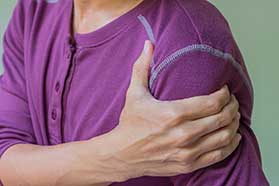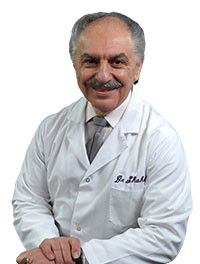Shoulder Labral Tear Surgery in Glen Rock, NJ

The shoulder is made up of three bones - the shoulder blade (scapula), the collarbone (clavicle) and the upper arm bone (humerus), as well as the associated ligaments and tendons. Your shoulder's stability depends on a band of cartilage called the labrum which lines the ball and socket joint (a special class of synovial joint which is responsible for motion) of your shoulder. When the labrum is torn, the tendons and ligaments attached to your labrum, as well as your shoulder's overall stability and function, become compromised.
There are two types of shoulder labral tears:
- Superior labrum, anterior (front) to posterior (back), or SLAP, are tears to the rim above the middle of the socket, which may also involve the biceps tendon.
- Bankart lesion are tears to the rim below the middle of the glenoid socket that involves the inferior glenohumeral ligament. Tears to the glenoid rim can often occur in combination with other shoulder injuries such as a dislocated shoulder (full or partial dislocation).
If your shoulder's labrum has torn and tendons have detached, an orthopedic surgeon will need to perform shoulder labral tear surgery by reattaching the torn tendons with absorbable tacks, wires or sutures. To schedule a consultation with a qualified surgeon in Glen Rock that can safely repair your shoulder's labrum, call (201) 806-6099 or contact Dr. M.T. Shahab online.
Causes for Shoulder Labral Tear Treatment
Those who most often require shoulder labral tear treatment are athletes who may overextend or put too much sudden force on their shoulders, such as baseball pitchers, golfers, volleyball players and weightlifters. Labral injuries may also occur as the result of a car crash or other unforeseen accidents such as:
- Falling on your arm when it is extended
- Taking a direct blow to your shoulder
- Suffering a sudden pull, such as when lifting a heavy object
Shoulder Labral Tear Symptoms
Your shoulder's labrum may be injured if you find you are experiencing:
- Pain when performing overhead activities
- Popping or grinding noises and catches or locks which can be traced to the shoulder
- Reduced range of motion
- Shoulder weakness and instability
Shoulder Labral Tear Tests
To determine the nature of your shoulder pain, your healthcare provider will likely ask you to recount the history of the injury. Your healthcare provider will then perform a shoulder labral tear test and run tests that check for range of motion, stability and strength. X-rays will likely be recommended to examine any other issues. Importantly, a tomography (CT) scan or magnetic resonance imaging (MRI) may be recommended in order to examine the rim of the shoulder socket, which is made of soft tissue often undetectable by an X-ray alone. A contrast medium, a substance which is used in medical imaging to enhance the contrast of structures or fluids within the body, may additionally be injected to detect tears in the tissue.
Shoulder Labral Repair Procedure
Initially, your healthcare provider will likely recommend anti-inflammatory medication, rehabilitation exercises to strengthen your rotator cuff and bicep and rest. If the extent of your injury is severe, surgical shoulder labral repair may be necessary.
Your healthcare provider will likely elect arthroscopic surgery in order to repair your labrum. The procedure utilizes a miniature camera called an arthroscope which is inserted through a small incision in your skin to examine the affected tissues around your shoulder joint. Once the camera is inserted and the tissues are examined, your healthcare provider will determine the extent of the injury and repair it, which usually involves one of the following courses:
- If the injury is isolated to the rim and does not affect the tendon, the shoulder is considered stable. The surgeon will remove the torn flap and correct any associated issues.
- If the tear extends into the bicep or tendon, or if it is detached, the shoulder is considered unstable. If this is the case, the surgeon will take steps to reattach your tendon by using absorbable tacks, wires or sutures.
Shoulder Labral Repair Surgery Recovery
Once the outpatient surgery is completed, your arm will likely be placed in a sling for three to four weeks. Your healthcare provider will also prescribe range of motion exercises. It is often recommended that you continue the exercises after your arm is out of the sling, and new ones may be added to help strengthen your bicep. Total recovery time for a shoulder labral repair surgery is generally three to four months but may vary depending on the extent of your injury.
A torn shoulder labral is painful and debilitating. Schedule an appointment with a surgeon that can restore function to your shoulder's labrum. Call (201) 806-6099 or contact Dr. M.T. Shahab online.
Medwell Orthopedics & Functional Medicine for Men & Women
Address
33 Central AveMidland Park, NJ 07432
(201) 806-6099
www.BergenCountyDoctors.com
Hours
Mon:
8:00 am - 8:00 pm
Tue:
2:00 pm - 7:00 pm
Wed:
8:00 am - 6:30 pm
Thu:
8:00 am - 1:00 pm
Fri:
8:00 am - 6:30 pm
Sat:
9:00 am - 1:00 pm
Sun:
By Appointment Only


